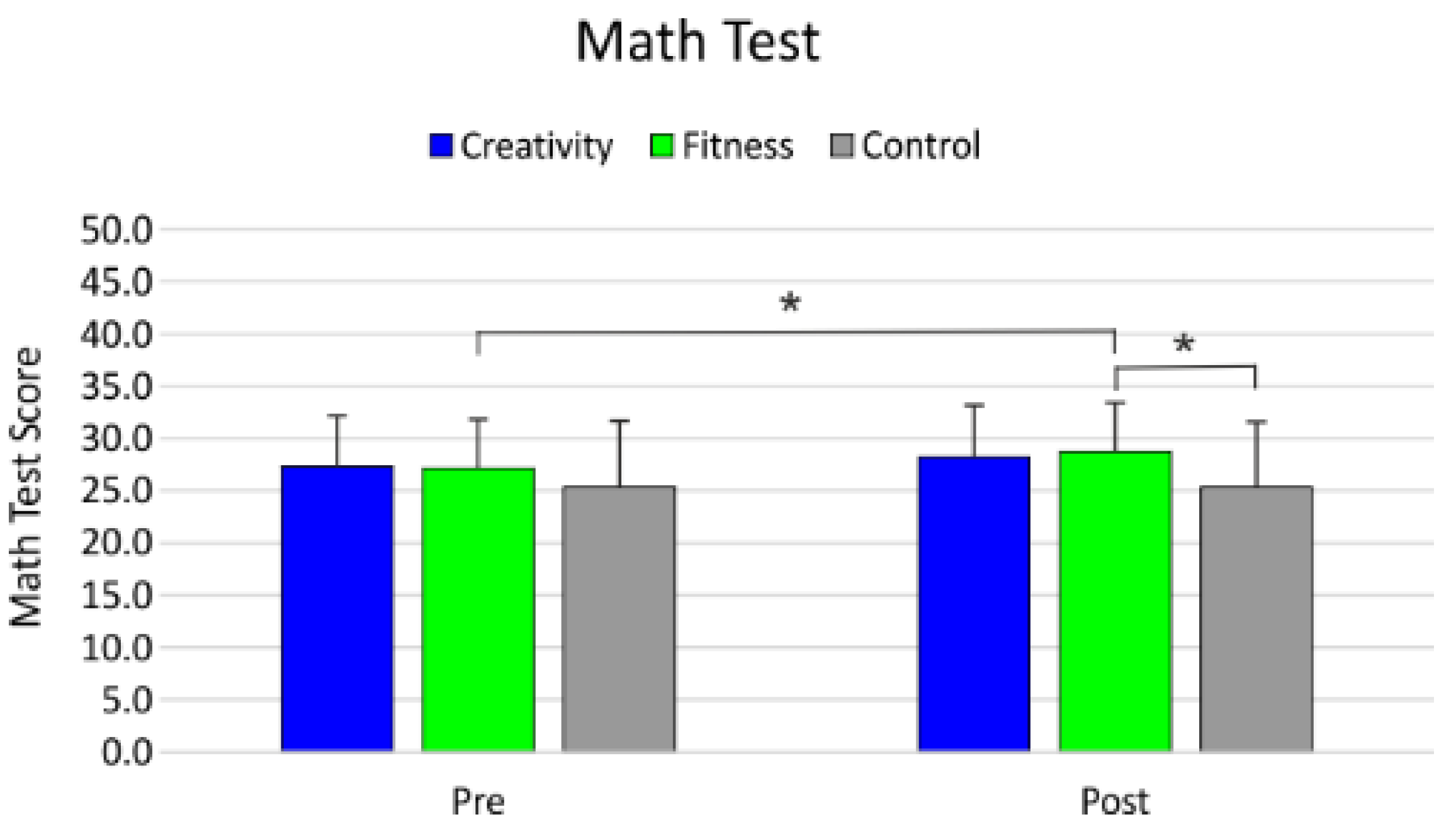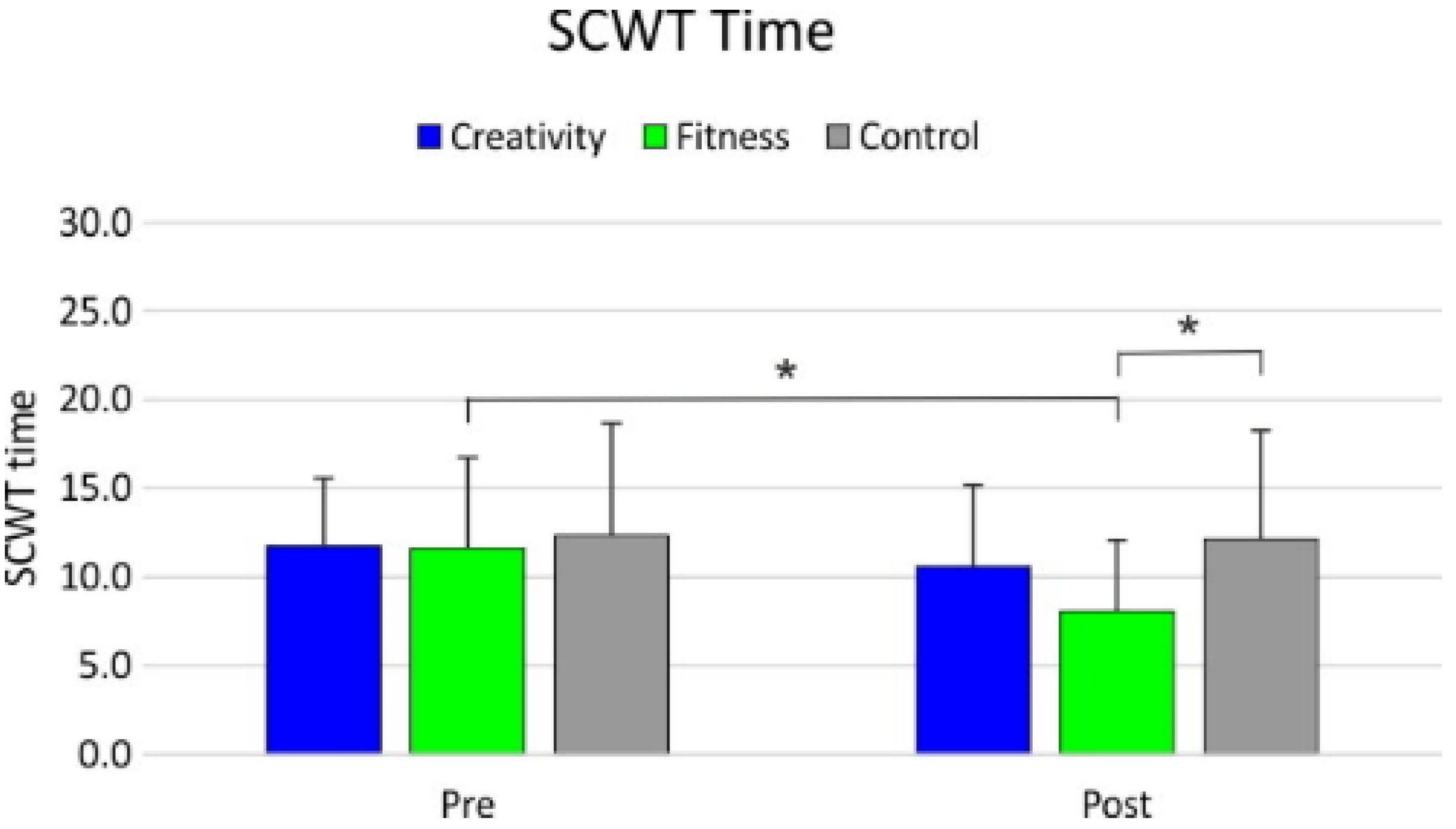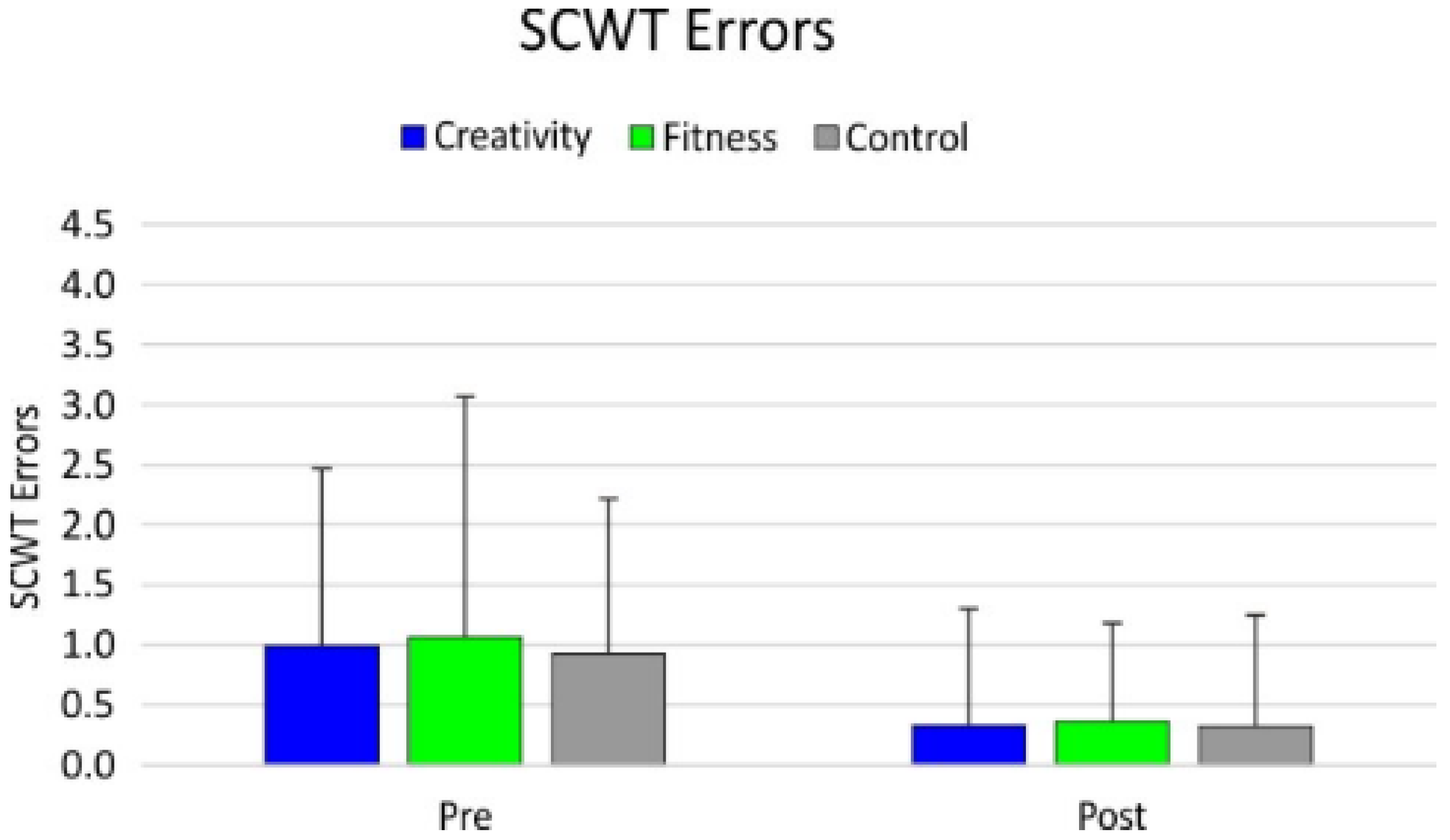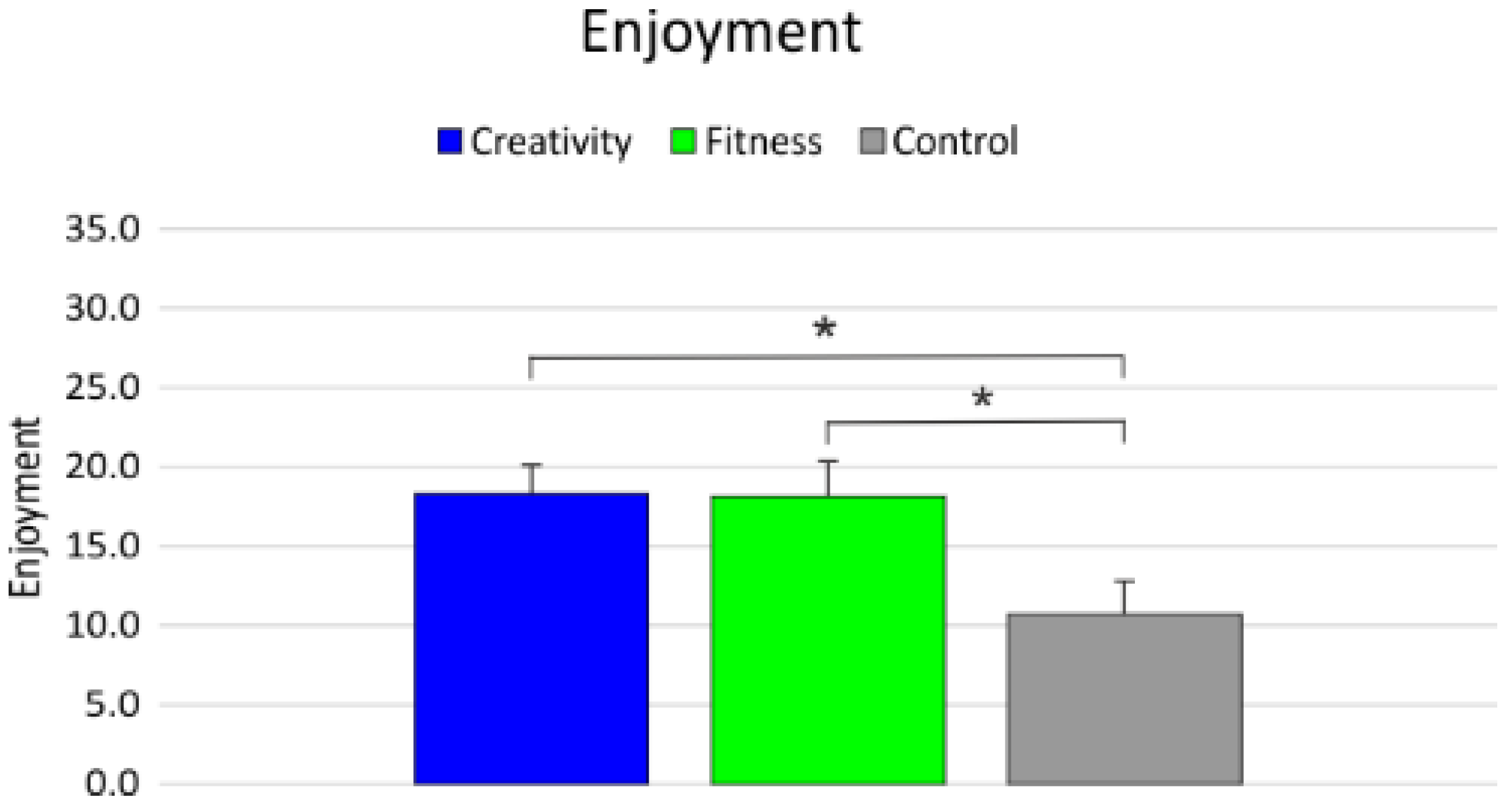Impact of Active Breaks in the Classroom on Mathematical Performance and Attention in Elementary School Children
Abstract
:1. Introduction
2. Materials and Methods
2.1. Study Design
2.2. Participants
2.3. Procedures
2.3.1. Math Test
2.3.2. Stroop Color and Word Test
2.3.3. Paces
2.4. Intervention
2.5. Statistical Analysis
3. Results
4. Discussion
Limitations
5. Conclusions
Author Contributions
Funding
Institutional Review Board Statement
Informed Consent Statement
Data Availability Statement
Acknowledgments
Conflicts of Interest
References
- Hillman, C.H.; Erickson, K.I.; Kramer, A.F. Be smart, exercise your heart: Exercise effects on brain and cognition. Nat. Rev. Neurosci. 2008, 9, 58–65. [Google Scholar] [CrossRef] [PubMed]
- Masini, A.; Marini, S.; Gori, D.; Leoni, E.; Rochira, A.; Dallolio, L. Evaluation of school-based interventions of active breaks in primary schools: A systematic review and meta-analysis. J. Sci. Med. Sport 2020, 23, 377–384. [Google Scholar] [CrossRef] [PubMed]
- di Cagno, A.; Buonsenso, A.; Baralla, F.; Grazioli, E.; Di Martino, G.; Lecce, E.; Calcagno, G.; Fiorilli, G. Psychological Impact of the Quarantine-Induced Stress during the Coronavirus (COVID-19) Outbreak among Italian Athletes. Int. J. Environ. Res. Public Health 2020, 17, 8867. [Google Scholar] [CrossRef] [PubMed]
- Booth, F.W.; Laye, M.J.; Roberts, M.D. Lifetime sedentary living accelerates some aspects of secondary aging. J. Appl. Physiol. 2011, 111, 1497–1504. [Google Scholar] [CrossRef] [PubMed]
- Fiorilli, G.; Iuliano, E.; Aquino, G.; Campanella, E.; Tsopani, D.; Di Costanzo, A.; Calcagno, G.; Di Cagno, A. Different consecutive training protocols to design an intervention program for overweight youth: A controlled study. Diabetes Metab. Syndr. Obes. Targets Ther. 2017, 10, 37–45. [Google Scholar] [CrossRef] [PubMed] [Green Version]
- Katzmarzyk, P.T.; Church, T.S.; Craig, C.L.; Bouchard, C. Sitting Time and Mortality from All Causes, Cardiovascular Disease, and Cancer. Med. Sci. Sports Exerc. 2009, 41, 998–1005. [Google Scholar] [CrossRef] [PubMed]
- Tremblay, M.S.; Aubert, S.; Barnes, J.D.; Saunders, T.J.; Carson, V.; Latimer-Cheung, A.E.; Chastin, S.F.; Altenburg, T.M.; Chinapaw, M.J. Sedentary Behavior Research Network (SBRN)—Terminology Consensus Project process and outcome. Int. J. Behav. Nutr. Phys. Act. 2017, 14, 75. [Google Scholar] [CrossRef] [Green Version]
- Boutios, S.; Fiorilli, G.; Buonsenso, A.; Daniilidis, P.; Centorbi, M.; Intrieri, M.; di Cagno, A. The Impact of Age, Gender and Technical Experience on Three Motor Coordination Skills in Children Practicing Taekwondo. Int. J. Environ. Res. Public Health 2021, 18, 5998. [Google Scholar] [CrossRef]
- Donnelly, J.E.; Hillman, C.H.; Castelli, D.; Etnier, J.L.; Lee, S.; Tomporowski, P.; Lambourne, K.; Szabo-Reed, A.N. Physical Activity, Fitness, Cognitive Function, and Academic Achievement in Children: A Systematic Review. Med. Sci. Sports Exerc. 2016, 48, 1197–1222. [Google Scholar] [CrossRef] [PubMed] [Green Version]
- McPherson, A.; Mackay, L.; Kunkel, J.; Duncan, S. Physical activity, cognition and academic performance: An analysis of mediating and confounding relationships in primary school children. BMC Public Health 2018, 18, 936. [Google Scholar] [CrossRef] [Green Version]
- Stoodley, C.J.; Valera, E.M.; Schmahmann, J.D. Functional topography of the cerebellum for motor and cognitive tasks: An fMRI study. NeuroImage 2012, 59, 1560–1570. [Google Scholar] [CrossRef] [Green Version]
- Chang, Y.K.; Labban, J.D.; Gapin, J.I.; Etnier, J.L. The effects of acute exercise on cognitive performance: A meta-analysis. Brain Res. 2012, 1453, 87–101. [Google Scholar] [CrossRef] [PubMed] [Green Version]
- Diamond, A.; Lee, K. Interventions Shown to Aid Executive Function Development in Children 4 to 12 Years Old. Science 2011, 333, 959–964. [Google Scholar] [CrossRef] [PubMed] [Green Version]
- Buman, M.P.; Winkler, E.A.; Kurka, J.M.; Hekler, E.B.; Baldwin, C.M.; Owen, N.; Ainsworth, B.E.; Healy, G.N.; Gardiner, P.A. Reallocating Time to Sleep, Sedentary Behaviors, or Active Behaviors: Associations With Cardiovascular Disease Risk Biomarkers, NHANES 2005–2006. Am. J. Epidemiol. 2014, 179, 323–334. [Google Scholar] [CrossRef]
- Grgic, J.; Dumuid, D.; Bengoechea, E.G.; Shrestha, N.; Bauman, A.; Olds, T.; Pedisic, Z. Health outcomes associated with reallocations of time between sleep, sedentary behaviour, and physical activity: A systematic scoping review of isotemporal substitution studies. Int. J. Behav. Nutr. Phys. Act. 2018, 15, 69. [Google Scholar] [CrossRef] [PubMed] [Green Version]
- Watson, A.; Timperio, A.; Brown, H.; Hesketh, K.D. Process evaluation of a classroom active break (ACTI-BREAK) program for improving academic-related and physical activity outcomes for students in years 3 and 4. BMC Public Health 2019, 19, 633. [Google Scholar] [CrossRef]
- Goh, T.L.; Hannon, J.C.; Webster, C.A.; Podlog, L. Classroom teachers’ experiences implementing a movement integration program: Barriers, facilitators, and continuance. Teach. Teach. Educ. 2017, 66, 88–95. [Google Scholar] [CrossRef]
- Howie, E.K.; Beets, M.W.; Pate, R.R. Acute classroom exercise breaks improve on-task behavior in 4th and 5th grade students: A dose–response. Ment. Health Phys Act. 2014, 7, 65–71. [Google Scholar] [CrossRef] [Green Version]
- Riley, N.; Lubans, D.R.; Holmes, K.; Morgan, P.J. Findings From the EASY Minds Cluster Randomized Controlled Trial: Evaluation of a Physical Activity Integration Program for Mathematics in Primary Schools. J. Phys. Act. Health 2016, 13, 198–206. [Google Scholar] [CrossRef]
- Bailey, C.G.; DiPerna, J.C. Effects of classroom-based energizers on primary grade Students’ physical activity levels. Phys. Educ. 2015, 72, 480. [Google Scholar]
- Stewart, G.; Webster, C.A.; Stodden, D.F.; Brian, A.; Egan, C.A.; Weaver, R.G. The association of children’s participation in school physical activity opportunities with classroom conduct. Int. J. Educ. Res. 2019, 97, 22–28. [Google Scholar] [CrossRef]
- Erwin, H.E.; Beighle, A.; Morgan, C.; Noland, M. Effect of a Low-Cost, Teacher-Directed Classroom Intervention on Elementary Students’ Physical Activity. J. Sch. Health 2011, 81, 455–461. [Google Scholar] [CrossRef] [PubMed]
- Gallè, F.; Pecoraro, P.; Calella, P.; Cerullo, G.; Imoletti, M.; Mastantuono, T.; Muscariello, E.; Ricchiuti, R.; Sensi, S.; Sorrentino, C.; et al. Classroom Active Breaks to Increase Children’s Physical Activity: A Cross-Sectional Study in the Province of Naples, Italy. Int. J. Environ. Res. Public Health 2020, 17, 6599. [Google Scholar] [CrossRef] [PubMed]
- Mavilidi, M.F.; Drew, R.; Morgan, P.J.; Lubans, D.R.; Schmidt, M.; Riley, N. Effects of different types of classroom physical activity breaks on children’s on-task behaviour, academic achievement and cognition. Acta Paediatr. 2020, 109, 158–165. [Google Scholar] [CrossRef] [Green Version]
- Hutchinson, J.C.; Jones, L.; Vitti, S.N.; Moore, A.; Dalton, P.C.; O’Neil, B.J. The influence of self-selected music on affect-regulated exercise intensity and remembered pleasure during treadmill running. Sport Exerc. Perform. Psychol. 2018, 7, 80–92. [Google Scholar] [CrossRef] [Green Version]
- Bigliassi, M.; Karageorghis, C.I.; Wright, M.; Orgs, G.; Nowicky, A.V. Effects of auditory stimuli on electrical activity in the brain during cycle ergometry. Physiol. Behav. 2017, 177, 135–147. [Google Scholar] [CrossRef]
- Chen, J.; Su, R.; Lv, Z.; Xiao, J.; Zhao, Y.; Wang, D.; Jiang, E. The Effect of Acute Aerobic Exercise with Music on Executive Function: The Major Role of Tempo Matching. Phys. Act. Health 2021, 5, 31–44. [Google Scholar] [CrossRef]
- Xue, Y.; Yang, Y.; Huang, T. Effects of chronic exercise interventions on executive function among children and adolescents: A systematic review with meta-analysis. Br. J. Sports Med. 2019, 53, 1397–1404. [Google Scholar] [CrossRef]
- Tomporowski, P.D.; McCullick, B.; Pendleton, D.M.; Pesce, C. Exercise and children’s cognition: The role of exercise characteristics and a place for metacognition. J. Sport Health Sci. 2015, 4, 47–55. [Google Scholar] [CrossRef] [Green Version]
- Gaida, J.E.; Seville, C.; Cope, L.; Dalwood, N.; Morgan, P.; Maloney, S. Acceptability of a blended learning model that improves student readiness for practical skill learning: A mixed-methods study. Focus Health Prof. Educ. 2016, 17, 3–17. [Google Scholar] [CrossRef]
- Nami, Y.; Marsooli, H.; Ashouri, M. The relationship between creativity and academic achievement. Procedia-Soc. Behav. Sci. 2014, 114, 36–39. [Google Scholar] [CrossRef] [Green Version]
- Naderi, H.; Abdullah, R.; Aizan, H.T.; Sharir, J.; Kumar, V. Relationship between creativity and academic achievement: A study of gender differences. J. Am. Sci. 2010, 6, 181–190. [Google Scholar]
- Schukajlow, S.; Leiss, D.; Pekrun, R.; Blum, W.; Müller, M.; Messner, R. Teaching methods for modelling problems and students’ task-specific enjoyment, value, interest and self-efficacy expectations. Educ. Stud. Math. 2012, 79, 215–237. [Google Scholar] [CrossRef]
- Hernik, J.; Jaworska, E. The effect of enjoyment on learning. In Proceedings of the INTED 2018 Conference, Valencia, Spain, 5–7 March 2018; pp. 508–514. [Google Scholar]
- Regard, M. Stroop Test–Victoria Version; Neuropsychological Laboratory, University of Victoria: Victoria, BC, Canada, 1981. [Google Scholar]
- Cornoldi, C.; Lucangeli, D.; Bellina, M. Test di Valutazione Delle Abilità di Calcolo e Soluzione dei Problemi Test di Valutazione Delle Abilità di Calcolo e Soluzione dei Problem; 6–11 AC-MT; Gruppo MT Edizioni Erickson: Trento, Italy, 2002. [Google Scholar]
- Carraro, A. Valutare il piacere nelle attività motorie: Il PACES-It. Ital. J. Educ. Res. 2008, 259–265. [Google Scholar]
- Nunnally, J.; Bernstein, I. Psychometric theory. In Introduction to Research in the Health Sciences; Polgar, S., Thomas, S.A., Eds.; Churchill Livingstone: Edinburgh, Scotland, 2000. [Google Scholar]
- Caffarra, P.; Vezzadini, G.; Dieci, F.; Zonato, F.; Venneri, A. A short version of the Stroop test: Normative data in an Italian population sample. Nuova Riv. Neurol. 2002, 12, 111–115. [Google Scholar]
- Golden, C.J. Identification of brain disorders by the Stroop Color and Word Test. J. Clin. Psychol. 1976, 32, 654–658. [Google Scholar] [CrossRef]
- Cohen, J. Statistical Power Analysis for the Behavioral Sciences, 2nd ed.; Lawrence Erlbaum Associates: Hillsdale, NJ, USA, 1988. [Google Scholar]
- Li, J.W.; O’Connor, H.; O’Dwyer, N.; Orr, R. The effect of acute and chronic exercise on cognitive function and academic performance in adolescents: A systematic review. J. Sci. Med. Sport 2017, 20, 841–848. [Google Scholar] [CrossRef] [PubMed]
- Yanagisawa, H.; Dan, I.; Tsuzuki, D.; Kato, M.; Okamoto, M.; Kyutoku, Y.; Soya, H. Acute moderate exercise elicits increased dorsolateral prefrontal activation and improves cognitive performance with Stroop test. NeuroImage 2010, 50, 1702–1710. [Google Scholar] [CrossRef] [PubMed]
- Lemay, S.; Bédard, M.A.; Rouleau, I.; Tremblay, P.L. Practice Effect and Test-Retest Reliability of Attentional and Executive Tests in Middle-Aged to Elderly Subjects. Clin. Neuropsychol. 2004, 18, 284–302. [Google Scholar] [CrossRef]
- Salinsky, M.C.; Storzbach, D.; Dodrill, C.B.; Binder, L.M. Test–retest bias, reliability, and regression equations for neuropsychological measures repeated over a 12–16-week period. J. Int. Neuropsychol. Soc. 2001, 7, 597–605. [Google Scholar] [CrossRef] [PubMed]
- Dikmen, S.S.; Heaton, R.K.; Grant, I.; Temkin, N.R. Test–retest reliability and practice effects of Expanded Halstead–Reitan Neuropsychological Test Battery. J. Int. Neuropsychol. Soc. 1999, 5, 346–356. [Google Scholar] [CrossRef] [PubMed]
- Rooks, C.R.; Thom, N.J.; McCully, K.K.; Dishman, R.K. Effects of incremental exercise on cerebral oxygenation measured by near-infrared spectroscopy: A systematic review. Prog. Neurobiol. 2010, 92, 134–150. [Google Scholar] [CrossRef] [PubMed]
- Best, J.R. Exergaming immediately enhances children’s executive function. Dev. Psychol. 2012, 48, 1501–1510. [Google Scholar] [CrossRef] [PubMed]
- Chang, Y.K.; Etnier, J.L. Exploring the Dose-Response Relationship between Resistance Exercise Intensity and Cognitive Function. J. Sport Exerc. Psychol. 2009, 31, 640–656. [Google Scholar] [CrossRef] [PubMed] [Green Version]
- Altenmüller, E.; Schlaug, G. Neurologic music therapy: The beneficial effects of music making on neurorehabilitation. Acoust. Sci. Technol. 2013, 34, 5–12. [Google Scholar] [CrossRef] [Green Version]
- Frith, E.; Loprinzi, P.D. Experimental effects of acute exercise and music listening on cognitive creativity. Physiol. Behav. 2018, 191, 21–28. [Google Scholar] [CrossRef] [PubMed]
- Runco, M.A.; Jaeger, G.J. The Standard Definition of Creativity. Creat. Res. J. 2012, 24, 92–96. [Google Scholar] [CrossRef]
- Chatzistamatiou, M.; Dermitzaki, I.; Efklides, A.; Leondari, A. Motivational and affective determinants of self-regulatory strategy use in elementary school mathematics. Educ. Psychol. 2015, 35, 835–850. [Google Scholar] [CrossRef]
- Pekrun, R. Emotions as Drivers of Learning and Cognitive Development. In New Perspectives on Affect and Learning Technologies; Calvo, R.A., D’Mello, S.K., Eds.; Springer: New York, NY, USA, 2011; pp. 23–39. [Google Scholar]
- Fiorilli, G.; Grazioli, E.; Buonsenso, A.; Di Martino, G.; Despina, T.; Calcagno, G.; di Cagno, A. A national COVID-19 quarantine survey and its impact on the Italian sports community: Implications and recommendations. PLoS ONE 2021, 16, e0248345. [Google Scholar] [CrossRef] [PubMed]
- Schmidt, M.; Benzing, V.; Kamer, M. Classroom-Based Physical Activity Breaks and Children’s Attention: Cognitive Engagement Works! Front. Psychol. 2016, 7, 1474. [Google Scholar] [CrossRef] [Green Version]
- Vazou, S.; Pesce, C.; Lakes, K.; Smiley-Oyen, A. More than one road leads to Rome: A narrative review and meta-analysis of physical activity intervention effects on cognition in youth. Int. J. Sport Exerc. Psychol. 2019, 17, 153–178. [Google Scholar] [CrossRef] [PubMed]




| Variable | n |
|---|---|
| Total | 141 |
| Age (Mean ± SD) | 9.61 ± 0.82 |
| Creativity | 9.58 ± 0.85 |
| Fitness | 9.57 ± 0.82 |
| Control | 9.66 ± 0.82 |
| Creativity | 40 |
| Male | 14 |
| Female | 26 |
| Third grade | 11 |
| Fourth grade | 18 |
| Fifth grade | 11 |
| Fitness | 51 |
| Male | 26 |
| Female | 25 |
| Third grade | 15 |
| Fourth grade | 19 |
| Fifth grade | 17 |
| Control | 50 |
| Male | 28 |
| Female | 22 |
| Third grade | 14 |
| Fourth grade | 17 |
| Fifth grade | 19 |
| Variable | F | p | pη2 | β |
|---|---|---|---|---|
| Sex | 3.60 | 0.060 | 0.028 | 0.469 |
| Group | 3.69 | 0.028 | 0.057 | 0.668 |
| Class | 2.47 | 0.089 | 0.039 | 0.488 |
| Sex by group | 2.59 | 0.079 | 0.040 | 0.509 |
| Sex by class | 1.08 | 0.343 | 0.017 | 0.236 |
| Group by class | 1.41 | 0.236 | 0.044 | 0.427 |
| Time | 10.82 | 0.001 | 0.081 | 0.904 |
| Time by sex | 3.45 | 0.066 | 0.027 | 0.454 |
| Time by group | 5.40 | 0.006 | 0.081 | 0.837 |
| Time by class | 2.44 | 0.091 | 0.038 | 0.484 |
| Variable | F | p | pη2 | β |
|---|---|---|---|---|
| Sex | 0.6 | 0.457 | 0.005 | 0.115 |
| Group | 3.1 | 0.050 | 0.047 | 0.582 |
| Class | 3.4 | 0.037 | 0.052 | 0.630 |
| Sex by group | 0.3 | 0.715 | 0.005 | 0.103 |
| Sex by class | 1.6 | 0.203 | 0.026 | 0.336 |
| Group by class | 0.2 | 0.952 | 0.006 | 0.085 |
| Time | 84.4 | 0.000 | 0.407 | 1.000 |
| Time by sex | 0.0 | 0.897 | 0.000 | 0.052 |
| Time by group | 18.4 | 0.000 | 0.230 | 1.000 |
| Time by class | 1.5 | 0.220 | 0.024 | 0.321 |
| Variable | F | p | pη2 | β |
|---|---|---|---|---|
| Sex | 0.2 | 0.643 | 0.002 | 0.075 |
| Group | 178.5 | 0.000 | 0.744 | 1.000 |
| Class | 4.2 | 0.017 | 0.064 | 0.730 |
| Sex by group | 0.2 | 0.848 | 0.003 | 0.075 |
| Sex by class | 0.8 | 0.463 | 0.012 | 0.179 |
| Group by class | 0.5 | 0.752 | 0.015 | 0.160 |
Publisher’s Note: MDPI stays neutral with regard to jurisdictional claims in published maps and institutional affiliations. |
© 2021 by the authors. Licensee MDPI, Basel, Switzerland. This article is an open access article distributed under the terms and conditions of the Creative Commons Attribution (CC BY) license (https://creativecommons.org/licenses/by/4.0/).
Share and Cite
Fiorilli, G.; Buonsenso, A.; Di Martino, G.; Crova, C.; Centorbi, M.; Grazioli, E.; Tranchita, E.; Cerulli, C.; Quinzi, F.; Calcagno, G.; et al. Impact of Active Breaks in the Classroom on Mathematical Performance and Attention in Elementary School Children. Healthcare 2021, 9, 1689. https://doi.org/10.3390/healthcare9121689
Fiorilli G, Buonsenso A, Di Martino G, Crova C, Centorbi M, Grazioli E, Tranchita E, Cerulli C, Quinzi F, Calcagno G, et al. Impact of Active Breaks in the Classroom on Mathematical Performance and Attention in Elementary School Children. Healthcare. 2021; 9(12):1689. https://doi.org/10.3390/healthcare9121689
Chicago/Turabian StyleFiorilli, Giovanni, Andrea Buonsenso, Giulia Di Martino, Claudia Crova, Marco Centorbi, Elisa Grazioli, Eliana Tranchita, Claudia Cerulli, Federico Quinzi, Giuseppe Calcagno, and et al. 2021. "Impact of Active Breaks in the Classroom on Mathematical Performance and Attention in Elementary School Children" Healthcare 9, no. 12: 1689. https://doi.org/10.3390/healthcare9121689
APA StyleFiorilli, G., Buonsenso, A., Di Martino, G., Crova, C., Centorbi, M., Grazioli, E., Tranchita, E., Cerulli, C., Quinzi, F., Calcagno, G., Parisi, A., & di Cagno, A. (2021). Impact of Active Breaks in the Classroom on Mathematical Performance and Attention in Elementary School Children. Healthcare, 9(12), 1689. https://doi.org/10.3390/healthcare9121689














